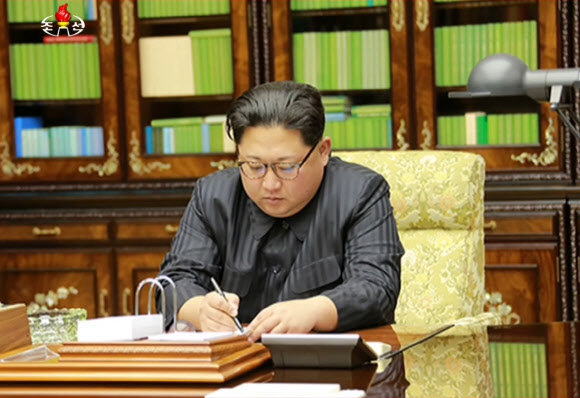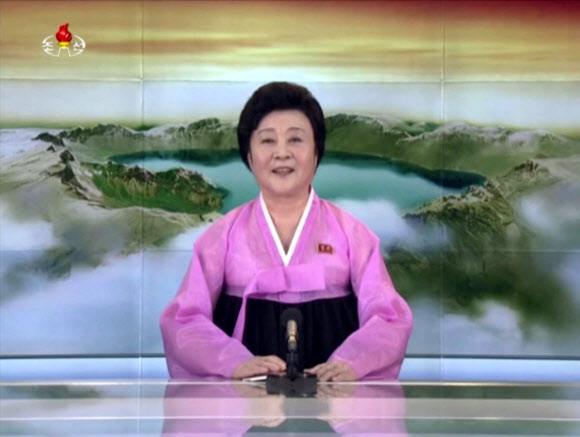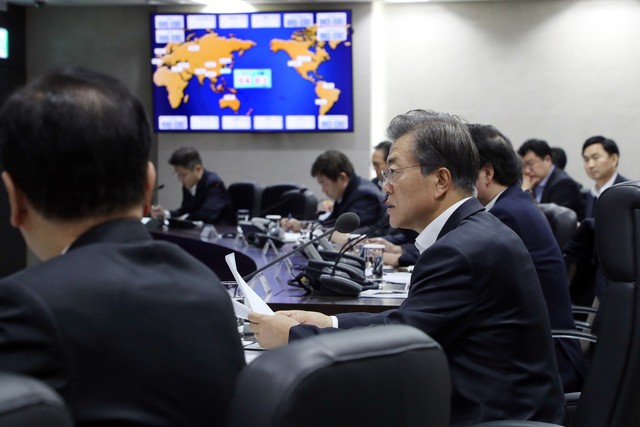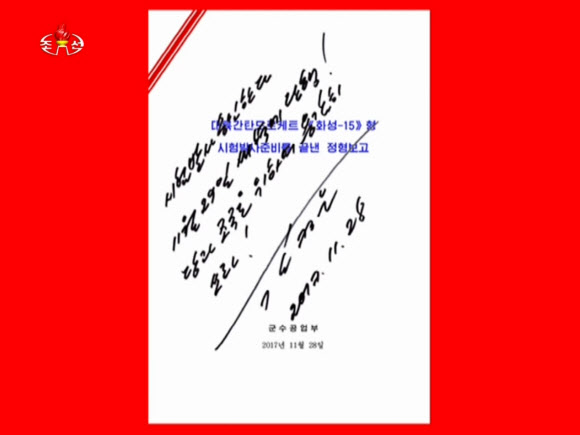Posted on : Nov.29,2017 14:02 KST
Modified on : Nov.29,2017 14:03 KST
 |
|
Korean Central TV released footage showing North Korean leader Kim Jong-un signs an order authorizing the launch of the Hwasong-15 ICBM on Nov. 19. (Yonhap News)
|
Preliminary analysis shows that the new weapon could reach Washington, D.C.
President Moon Jae-in called an emergency general meeting of the National Security Council (NSC) on Nov. 29 in connection with a North Korean ballistic missile launch that took place earlier that morning.
“An unverified North Korean launch vehicle was fired at 3:17 am today. NSC chief Chung Eui-yong made the first report to the President two minutes later at 3:19, and a second report at 3:24. President Moon ordered an NSC meeting in response,” said a spokesman for the Blue House. The NSC meeting took place at 6 am.
Early that morning, North Korea launched a long-range missile that the Korea Central News Agency later announced was a newly developed Hwasong-15 missile. The KCNA reported a government statement describing the Hwasong -15 as “the completion of the great historical work to create a state nuclear force” and that North Korea now had the potential put the entire US mainland under threat of a nuclear attack.
 |
|
A presenter makes a special announcement on North Korea‘‘s state-run television after the country launched a missile, in this still image taken from a video released by KRT, November 29, 2017
|
In a separate announcement, the South Korean Joint Chiefs of Staff (JCS) explained, “The long-range ballistic missile launched by North Korean toward the East Sea from the area of Pyongsong, South Pyongan Province, at 3:17 am today had an altitude of around 4,500 km and an estimated flight distance of around 960 km.”
“South Korea and the US are closely analyzing the detailed data,” the JCS added.
North Korea’s latest missile launch comes 75 days after it launched its Hwasong-12 intermediate-range ballistic missile (IRBM) over Japanese skies toward the northern Pacific Ocean on Sept. 15. It is the first missile launched by North Korea from its Pyongsong region.
With a missile’s flight distance equaling two to three times its altitude, the missile is believed to have been an ICBM capable of traveling more than 10,000 km. It reached the highest of altitude of any of the missiles launched by North Korea, and was the first to top 4,000 km in altitude. The Hwasong-12 launched on Sept. 15 had a maximum altitude of around 770 km and a flight distance of around 3,700 km.
In response, US President Donald Trump told reporters in Washington, D.C. that, “this is a situation that we will handle. We will take care of it,” while noting that he had a “long discussion” with US Defense Secretary James Mattis regarding possible responses to the missile launch. Trump also spoke with President Moon later in the day to reiterate the joint strategy of maintaining “maximum pressure and sanctions” on North Korea, despite little evidence that this policy has had an effect on the Kim Jong-un regime.
“The two leaders strongly condemned North Korea for again launching a long-range ballistic missile despite the international community’s repeated warnings and its continued sanctions and pressure under a series of UN Security Council resolutions,” said Blue House spokesman Park Soo-hyun.
The US and Japan agreed that the missile launched was likely to have been an ICBM. In a briefing, Pentagon spokesperson Robert Manning said the US had detected the launch of what appeared to be an ICBM by North Korea.
“The missile was launched from Sain-Ni [in the vicinity of Pyongyang] and traveled about 1000 km before splashing down in the Sea of Japan [East Sea], within Japan's Exclusive Economic Zone (EEZ),” Manning said.
 |
|
President Moon Jae-in presides over a meeting of the National Security Council that took place at 6 am following the latest test launch of a North Korean ICBM on Nov. 29. (Yonhap News)
|
The Japanese Ministry of Defense also concluded the North Korean missile was an ICBM.
In a statement on the North Korean long-range missile launch, US Secretary of Defense Rex Tillerson said the US “strongly condemns North Korea’s launch of what is likely an intercontinental ballistic missile into the Sea of Japan, indiscriminately threatening its neighbors, the region and global stability.”
“The DPRK.’s relentless pursuit of nuclear weapons and the means to deliver them must be reversed,” Tillerson continued. “Together the international community must continue to send a unified message to North Korea that the DPRK must abandon its WMD programs.”
“In addition to implementing all existing UN sanctions, the international community must take additional measures to enhance maritime security, including the right to interdict maritime traffic transporting goods to and from the D.P.R.K.,” he stressed.
The South Korean military staged precision strike training exercises in response to provocations six minutes after the North Korean missile launch.
“In response to the North Korean ballistic missile provocation, joint missile precision strike exercises were conducted from 3:23 to 3:44 am today, applying a simultaneous ground/sea/air impact concept in light of the distance from the East Sea to the source of the enemy provocation,” the JCS explained.
Weaponry used in the joint precision strike exercises included the 300-km Hyeonmu-2 ballistic missile, the 1,000-km ship-to-surface missile Haeseong II, and the 57-km air-to-surface missile SPICE-2000.
“One missile each was launched, with the three launched simultaneously toward a target selected as [symbolizing] the source of an enemy provocation,” the JCS said.
The UN Security Council will hold an urgent meeting in New York City on Nov. 29 to discuss the latest missile launch.
By Seong Yeon-cheol, staff reporter
Please direct questions or comments to [english@hani.co.kr]












